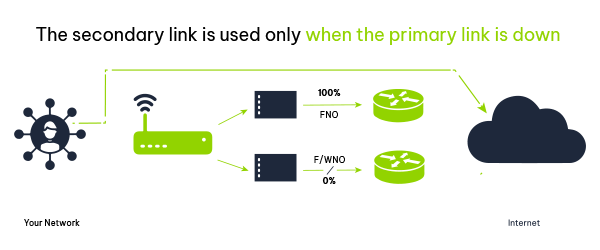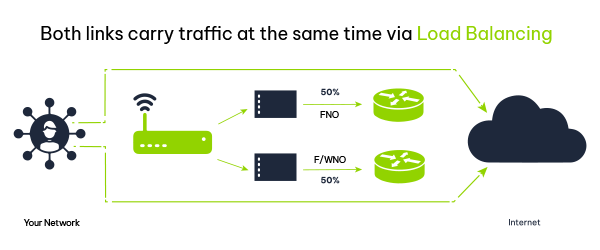When your business can’t afford to have its network go down, you need more than a backup: you need intelligent, always‑on connectivity.
Enter Vox Active‑Active Failover: a high‑availability solution that uses two live links at the same time for better performance, more usable bandwidth and seamless resilience when one link fails.
Why failover matters for your business
Imagine driving to work and discovering a massive traffic jam on your usual route. A quick off‑ramp saves the day and you arrive on time. That’s exactly what a failover does for your network. Whether you rely on cloud services, VoIP, payments or remote access, even a short outage can cost time, revenue and reputation. Failover options keep your services running when faults or outages happen.
Failovers make sure that systems stay operational even when unexpected failures occur. They guarantee that users experience negligible disruption, just like the alternative traffic route. Failover is a critical part of IT resilience, helping companies to navigate these challenges with minimal impact to the business.
Vox is proud to announce our newest business Failover bundle options, which go beyond the traditional parameters in an exciting and innovative way. This article unpacks our new ‘Active-Active Failover solution’, which is unique in the South African ISP landscape and designed to assist with significantly reducing and controlling network disruptions.
Active-Passive Failover Operations: Keeping Your Internet Alive
There are many reasons why Internet networks fail, including congestion, physical damage to the Fibre, area outages, planned or emergency maintenance, router issues, DDoS attacks, malware on devices, outdated software on customer equipment, and more.
Setting up a Failover option helps organisations to remain ready for any challenge. The alternative option – no Failover plan (unthinkable!) – leads to downtime, causing financial and reputational damage. ‘Active-Passive Failovers’, which have been the standard offering to date, provide a secondary connection to your organisation’s Internet – preferably on diverse infrastructure – where the secondary link is used only once the primary link goes down.
How it works: In a typical Active-Passive Failover configuration, one is configured as primary (Active) and the other as backup (Passive), as shown in the diagram below. If the primary network connection fails or is unresponsive, the backup automatically takes over. Network parameters are shared so that other devices on the network can continue operating as if nothing has changed. When the primary wide area network (WAN) link is restored and once again stable, the connections ‘failback’ to it.
In this example, the primary network link is via a Fibre network operator (FNO). The secondary link can be provided by either another FNO, or alternatively via a Wireless network operator (WNO). The secondary link is used only when the primary link is down.

- When the primary link is active, 100 percent of the traffic goes through it and zero percent via the secondary link.
- The situation is the exact opposite when the primary link is down, when 100 percent of the traffic goes through the secondary link.
- When the primary link is restored and the connections failback to it, zero percent of the traffic once again goes through the secondary link.
Vox has been providing Active-Passive Failover systems for many years and has built up significant expertise to assist our customers. Recently, however, we started thinking: ‘What if we can provide more value to a failover customer at similar price points as on Active-Passive?’
And guess what? We can!
Introducing the Active-Active Option: A Failover Plan on Steroids
Vox is proud to present our new ‘Active-Active Failover’ bundle options. (And no, this is not a term that applies to busy toddlers having a meltdown.)
The problem with the Active-Passive Failover option outlined above is that a customer can only use one link at a time – the secondary link hardly gets used. Here at Vox, we thought that this seemed like a waste of potential ‘always-on’ connectivity.
The Vox Active-Active Failover option solves this problem by allowing customers to use both network links at the same time via load balancing, giving them more available bandwidth when both links are up. Then, when one link goes down, the secondary link will still work as a Failover to keep pushing traffic.
- Technology note: ‘Load balancing’ in this context is the process of distributing network traffic across multiple links.
How it works: In the example in the image, both the networks are used in tandem. Again, the primary link is provided by an FNO, while the secondary link can be provided by either another FNO, or alternatively via a WNO.

- When both links are available, the traffic is load-balanced based on the capacities configured per link.
- When one of the Active links are down, all the traffic fails over to the remaining link.
- When the broken link is restored, the load balancing will reestablish.
Vox’s Active-Active Failover solution is unique in the South African market, as it delivers customers more value while saving costs, and without compromising on the essence of network redundancy. An Active-Active Failover bundle is ideal for any organisation where having no down-time is vital.
Active-Active Benefits:
The benefits of using your links to their fullest potential all the time are groundbreaking. Think about implementing these positives for your business:
- Business continuity due to increased uptime: The probability for downtime reduces drastically with two links on distinct networks.
- More value for money: With both links able to carry traffic, the Failover can almost always be used.
- Improved cost efficiencies: There is no need for additional devices and licences; it is all delivered on the included router.
- Bandwidth efficiencies with burstability: More bandwidth is at the customer’s disposal when both links are up.
- Peace of mind with seamless Failover: If one link fails, the other continues to carry the traffic in an uninterrupted manner.
- Vox does everything for our customers: We provide the links, the Active Failover setup on the included router, and the support that comes with it.
Our current offerings start from R1,798 (ex VAT) per month. Currently, the Active-Active solution is offered through either Fibre plus Fibre, or Fibre plus Wireless, but the offering could also be offered via other technologies. It depends on what’s available at the customer’s site, and what they can afford.
Vox is enormously proud to be the first local ISP to officially offer the Active-Active Failover solution! We look forward to bringing you even more options in the future.
For more information, please contact us through this convenient enquiry page and we’ll call you back promptly.
Frequently Asked Questions
What is Vox Active‑Active Failover?
Vox Active‑Active Failover is a managed connectivity bundle that uses two live internet links concurrently. Traffic is load‑balanced across both links and automatically fails over to the remaining link if one fails, ensuring continuous connectivity.
How does Active‑Active differ from Active‑Passive?
Active‑Passive keeps a standby link for use only when the primary fails. Active‑Active uses both links simultaneously for increased usable bandwidth and continuous redundancy.
Which link types can be used in an Active‑Active bundle?
Vox currently offers Active‑Active as Fibre + Fibre or Fibre + Wireless. Availability depends on the technologies present at your location.
Will I need extra hardware for Active‑Active?
No additional customer hardware is usually required. Vox supplies and configures the router included in the bundle to manage load balancing and failover.
How much does Vox Active‑Active cost?
Packages start from R1,798 (ex VAT) per month. The final cost depends on the selected speeds and any optional add‑ons such as static IP ranges or QoS VLANs.
What happens if both links fail?
Having diverse links reduces the chance of simultaneous failure. If both links do fail, Vox provides support to restore service and can offer temporary connectivity options where available.
Is Active‑Active suitable for small businesses?
Yes. Any business that values uptime, small or large, can benefit from the redundancy and performance gains of Active‑Active.
How quickly does failover happen?
Failover switching is automatic and happens within seconds depending on the configuration, keeping interruptions to a minimum.















